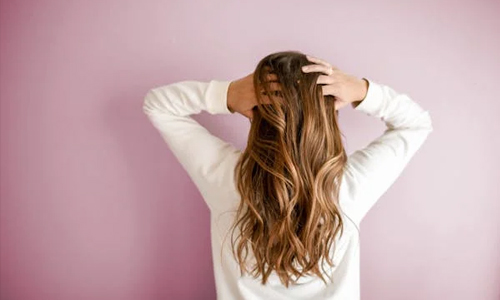Luscious, healthy hair is a crowning glory, but achieving it takes more than just a good shampoo. Preventative hair care is the key to maintaining strong, vibrant locks and preventing future damage. This comprehensive guide delves into everything you need to know to keep your hair healthy from root to tip.
Understanding Hair Health
Hair health starts with understanding its structure. Hair is made primarily of keratin, a protein produced by the hair follicles in your scalp. These follicles also require a healthy supply of blood to function optimally. Several factors can impact your hair health, including:
Genetics
Hair type, texture, and predisposition to thinning are all influenced by your genes.
Diet
A balanced diet rich in protein, vitamins, and minerals nourishes the scalp and promotes hair growth.
Stress
Chronic stress can disrupt hair growth cycles and lead to hair loss.
Hormonal Changes
Fluctuations in hormones, such as during pregnancy or menopause, can affect hair growth patterns.
Medical Conditions
Certain medical conditions or medications can contribute to hair loss.
Preventative Hair Care Regimen
Now that you understand the foundation of hair health, let’s explore a preventative hair care routine:
Scalp Care

A healthy scalp is essential for healthy hair growth. Regularly massage your scalp with oil to stimulate blood flow and loosen dead skin cells. Look for shampoos and conditioners that address specific scalp concerns like dryness, flakiness, or irritation. Consider a scalp scrub once a week to remove product buildup and promote a healthy environment for hair growth.
Nourish from Within
Maintaining a balanced diet rich in protein, vitamins A, C, E, and D, iron, and omega-3 fatty acids provides the building blocks for strong, healthy hair. Consider incorporating supplements like biotin or fish oil after consulting a healthcare professional.
Hydration is Key
Just like your skin, hair needs hydration to stay healthy and prevent breakage. Drink plenty of water throughout the day and use moisturizing hair products with ingredients like hyaluronic acid or glycerin.
Gentle Cleansing
Shampooing removes dirt, product buildup, and excess oil from the scalp. However, over-washing can strip your hair of its natural oils. Aim to shampoo 2-3 times per week, depending on your hair type and activity level. Use a gentle, sulfate-free shampoo that cleanses without being harsh.
Conditioning is Crucial
Conditioner replenishes moisture, detangles hair, and improves manageability. Focus on applying conditioner to the mid-lengths and ends of your hair, avoiding the roots. Consider deep conditioning treatments once or twice a month for extra moisture.
Heat Styling with Caution
Minimize heat styling with tools like blow dryers, straighteners, and curling irons. When you do use them, apply a heat protectant spray beforehand to shield your hair from heat damage. Let your hair air dry whenever possible.
Brush Wisely
Detangle your hair gently with a wide-tooth comb before shampooing to minimize breakage. Use a soft-bristled brush to avoid scratching your scalp. Avoid brushing your hair when wet, as it’s more susceptible to breakage.
Embrace Protective Styles
Tight hairstyles like braids, cornrows, or ponytails can cause tension on the scalp and lead to traction alopecia. Opt for looser styles and avoid wearing the same style for extended periods.
Regular Trims
Split ends can travel up the hair shaft, causing breakage. Regular trims (every 6-8 weeks) help prevent this and keep your hair looking healthy.
Addressing Specific Hair Concerns
Dry Hair
Use hydrating shampoos and conditioners. Deep condition regularly and incorporate leave-in conditioners or hair oils for extra moisture.
Oily Hair
Look for shampoos formulated for oily hair. Clarify your scalp occasionally to remove excess oil buildup. However, avoid over-washing, which can stimulate your scalp to produce more oil.
Thinning Hair
Consult a dermatologist to rule out any underlying medical conditions. Minoxidil is a topical medication approved by the American Academy of Dermatology Association for hair loss. Hair growth supplements may also be helpful, but discuss with your doctor first.
Colored Hair
Color-treated hair requires extra care. Use shampoos and conditioners specifically formulated for color-treated hair to preserve vibrancy and prevent fading. Minimize heat styling and use cool water for rinsing to lock in color. Consider hair masks specifically designed for color-treated hair for extra nourishment.
Curly Hair
Curly hair requires a different approach. Use a co-washing method (cleansing with conditioner) to gently cleanse without stripping away natural oils. Deep conditioning is essential for curly hair. Apply styling products like leave-in conditioners and curl creams to define your curls and combat frizz.
Lifestyle Habits for Healthy Hair
Manage Stress
Chronic stress can disrupt hair growth cycles. Practice stress-management techniques like yoga, meditation, or deep breathing exercises.
Get Enough Sleep
Aim for 7-8 hours of sleep per night. During sleep, your body repairs and restores itself, including your hair follicles.
Limit Alcohol and Smoking
Excessive alcohol consumption and smoking can contribute to hair loss.
Seeking Professional Help
If you’re experiencing significant hair loss, scalp problems, or persistent hair concerns, consult a dermatologist or trichologist (a hair specialist). They can diagnose the underlying cause and recommend appropriate treatment options.
Preventative hair care is an investment in your long-term hair health. By incorporating these tips into your routine, you can keep your hair strong, healthy, and beautiful for years to come. Remember, consistency is key! Don’t be discouraged if you don’t see results overnight. With dedication to a healthy lifestyle and a preventative hair care regimen, you’ll be well on your way to achieving your hair goals.
Embrace your natural hair texture and make the most of your unique locks. With a little knowledge and preventative care, you can showcase your hair’s full potential and rock your mane with confidence!
